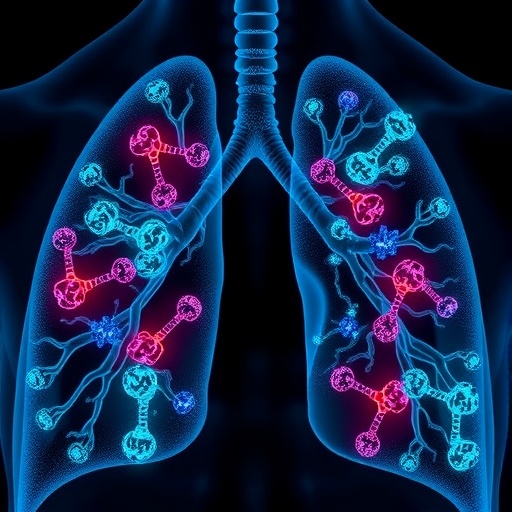In the ever-evolving landscape of cancer research, a groundbreaking study has emerged highlighting the role of three specific genes—DCN, NPM3, and SULF1—in the phenomenon known as vasculogenic mimicry (VM) in lung adenocarcinoma. Conducted by a team led by researchers Sun, C., Ye, M., and Cao, W., the study sheds light on the crucial relationship between these hub genes and their potential impact on cancer progression and treatment strategies. As lung adenocarcinoma remains one of the most prevalent and lethal forms of lung cancer worldwide, understanding the molecular pathways involved in its aggressiveness could pave the way for innovative therapeutic options.
Vasculogenic mimicry is a unique ability of cancer cells to form vessel-like structures that enable tumor growth and metastasis. This phenomenon is particularly significant in aggressive tumors like lung adenocarcinoma, where traditional angiogenesis—the formation of new blood vessels from pre-existing ones—falls short. The identification of VM has introduced new paradigms in the understanding of tumor vascularity and has led researchers to explore the underlying genetic factors that contribute to this process.
In their investigation, the authors employed a variety of experimental techniques to analyze the expression levels of DCN, NPM3, and SULF1 in lung adenocarcinoma specimens. Through comprehensive bioinformatics analysis, they were able to determine that these genes serve as key regulators of VM. Notably, the study revealed that elevated expression of these hub genes correlates with poorer patient outcomes, suggesting a potential prognostic value linked to VM in lung cancer patients.
The study goes beyond mere observational analysis; it delves into the mechanistic intricacies of how these genes contribute to the establishment of vasculogenic mimicry. DCN, known for its role in extracellular matrix remodeling, was found to interact with key signaling pathways that promote tumor cell motility and invasiveness. By influencing the microenvironment surrounding the tumor, DCN facilitates the adaptation of cancer cells to hypoxic conditions, ultimately fostering the formation of vessel-like structures.
Similarly, NPM3, which is associated with various cellular processes including gene expression and nucleolar dynamics, has emerged as a pivotal player in the modulation of vascular mimicry. The research findings indicate that NPM3 influences the activation of signaling pathways crucial for VM, highlighting its potential as a therapeutic target. The role of SULF1, an enzyme involved in the modification of heparan sulfate proteoglycans, adds another layer to this complex interaction, further elucidating how these genes interconnect to promote tumor survival and progression through VM.
The implications of these findings are significant, not only for the scientific understanding of lung adenocarcinoma but also for clinical applications. With the identification of DCN, NPM3, and SULF1 as key players in vasculogenic mimicry, there exists an opportunity for the development of targeted therapies aimed at disrupting these molecular pathways. Such interventions could enhance the efficacy of existing treatment modalities and improve patient prognoses.
Moreover, the study encourages further investigation into the role of vasculogenic mimicry in other cancer types. Given the universal challenge of tumorigenesis, exploring similar genetic signatures across various malignancies could uncover shared vulnerabilities and lead to the establishment of pan-cancer therapeutic approaches. This kind of research could significantly shift paradigms in oncology, moving away from broad-spectrum chemotherapy toward more personalized medicine strategies that target specific genetic alterations driving malignancy.
The increasing recognition of the importance of the tumor microenvironment in cancer biology cannot be overstated. As cancers evolve, they adapt not only to the host’s immune responses but also to the architectural and biochemical cues from their surroundings. By unraveling the genetic components implicated in these processes, researchers can gain a better understanding of cancer development and progression, ultimately guiding the design of more effective therapies.
The study by Sun and colleagues serves as a catalyst for future research initiatives aimed at unraveling the complexities of cancer biology. The findings have already garnered interest from the broader scientific community, prompting discussions about the feasibility of translating these insights into clinical practice. Collaborative efforts among researchers, clinicians, and biopharmaceutical companies will be essential to explore the therapeutic potential of targeting DNC, NPM3, and SULF1.
As the landscape of cancer research grows increasingly intricate, the importance of interdisciplinary approaches becomes more apparent. By bridging the gap between basic research and clinical application, scientists can accelerate the development of new therapeutics. This study stands as a testament to the potential that lies in understanding the genetic underpinnings of cancer, particularly in the context of aberrant processes like vasculogenic mimicry.
In conclusion, the findings from this research illuminate critical pathways that contribute to the aggressiveness of lung adenocarcinoma and provide new avenues for innovative treatment strategies. The identification of DCN, NPM3, and SULF1 as hub genes related to vasculogenic mimicry marks a significant step forward in unraveling the complexities of cancer biology and developing more targeted therapeutic interventions. As research progresses, the hope is that these discoveries will translate into improved outcomes for patients battling this devastating disease.
Subject of Research: The relationship between hub genes DCN, NPM3, and SULF1 and vasculogenic mimicry in lung adenocarcinoma.
Article Title: DCN, NPM3 and SULF1 are hub genes related to vasculogenic mimicry in lung adenocarcinoma.
Article References:
Sun, C., Ye, M., Cao, W. et al. DCN, NPM3 and SULF1 are hub genes related to vasculogenic mimicry in lung adenocarcinoma.
J Cancer Res Clin Oncol 151, 318 (2025). https://doi.org/10.1007/s00432-025-06361-0
Image Credits: AI Generated
DOI: https://doi.org/10.1007/s00432-025-06361-0
Keywords: lung adenocarcinoma, vasculogenic mimicry, cancer genetics, DCN, NPM3, SULF1, targeted therapy, tumor microenvironment.




